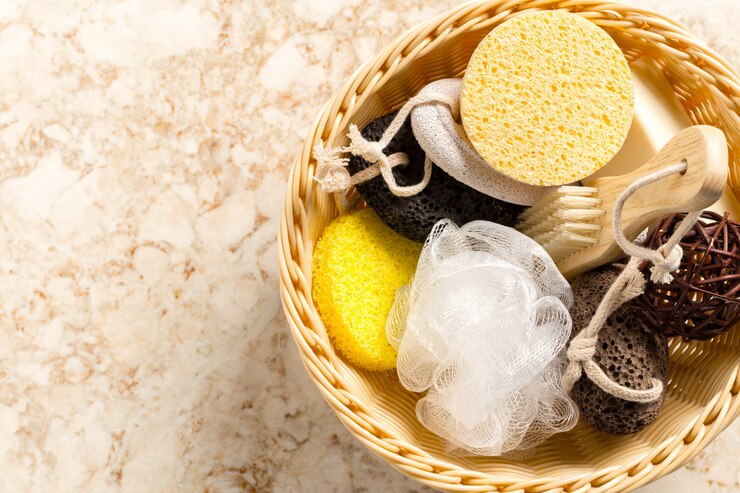Loofahs have been a staple in skincare routines for centuries, prized for their exfoliating properties and numerous benefits for the skin. Whether you’re a skincare enthusiast or someone looking to improve their bathing experience, incorporating a loofah into your routine can make a significant difference. In this article, we’ll explore the various benefits of using a loofah, how to use it properly, precautions to consider, and tips for choosing the right one for your needs.
Introduction to Loofah
Before diving into the benefits, let’s first understand what a loofah is. Contrary to popular belief, a loofah isn’t a sea sponge but rather the dried fibrous interior of the fruit from the Luffa genus of plants. These plants belong to the cucumber family and are native to tropical and subtropical regions. When the fruit matures, it develops a fibrous network inside, which, when dried, forms the familiar scrubbing tool we know as a loofah.
What is a Loofah?
A loofah is a natural exfoliating sponge that is widely used in skincare routines to remove dead skin cells, dirt, and impurities. It has a rough texture that helps slough away dead skin, leaving behind smooth and radiant skin. There are two main types of loofahs: natural and synthetic.
Types of Loofahs
Natural Loofah
Natural loofahs are made from the fibrous interior of the Luffa plant. They are biodegradable, eco-friendly, and offer excellent exfoliation.
Synthetic Loofah
Synthetic loofahs, on the other hand, are made from materials like plastic or nylon. While they may last longer than natural loofahs, they are not as environmentally friendly and may harbor bacteria more easily.
Using a Loofah
Exfoliation
One of the primary benefits of using a loofah is its exfoliating properties. The rough texture of the loofah helps remove dead skin cells, revealing smoother and healthier-looking skin underneath. Regular exfoliation can also prevent clogged pores and acne breakouts.
Improved Circulation
Using a loofah stimulates blood flow to the skin, promoting better circulation. This can help deliver oxygen and nutrients to the skin cells, resulting in a more youthful and radiant complexion.
Skin Cell Renewal
Exfoliating with a loofah encourages the turnover of skin cells, helping to remove dull and dry patches and promote the growth of new, healthy cells. This can result in softer, smoother skin with a more even tone and texture.
Skin Glow
Regular use of a loofah can help give your skin a natural glow by removing dead skin cells and revealing fresher, brighter skin underneath. This can make your skin look more radiant and youthful.
Stimulating Lymphatic System
The gentle scrubbing motion of using a loofah can help stimulate the lymphatic system, which plays a crucial role in detoxifying the body and supporting the immune system. This can help reduce swelling and puffiness in the skin, giving it a firmer and more toned appearance.
How to Use a Loofah Properly
To get the most out of your loofah, it’s essential to use it correctly. Here’s a step-by-step guide:
- Wetting the Loofah: Before using the loofah, wet it thoroughly with warm water to soften the fibers.
- Applying Soap or Body Wash: Apply your favorite soap or body wash to the wet loofah.
- Gently Scrubbing the Skin: Using circular motions, gently scrub your skin with the loofah, focusing on areas prone to dryness or roughness.
- Rinse and Dry: After use, rinse the loofah thoroughly with water and allow it to dry completely in a well-ventilated area to prevent bacteria growth.
Precautions and Risks
Over-Exfoliation
Exfoliating too often or too vigorously with a loofah can irritate the skin and lead to redness, inflammation, and even micro-tears. It’s best to limit exfoliation to 2-3 times a week, especially for those with sensitive skin.
Bacteria Build-Up
Loofahs can harbor bacteria and mold if not properly cleaned and dried after each use. To prevent bacterial growth, make sure to rinse the loofah thoroughly after each use and replace it regularly, ideally every 3-4 weeks.
Choosing the Right Loofah for You
When selecting a loofah, consider the following factors:
- Material: Choose a loofah made from natural fibers for a more eco-friendly option.
- Texture: Opt for a loofah with a medium texture that provides gentle exfoliation without being too abrasive.
- Size: Select a loofah that fits comfortably in your hand and is easy to maneuver over your body.
Incorporating Loofah into Your Skincare Routine
To incorporate a loofah into your skincare routine, consider the following tips:
- Daily Use: Use the loofah daily as part of your shower or bath routine to keep your skin smooth and radiant.
- Weekly Exfoliation: For deeper exfoliation, use the loofah 2-3 times a week to remove dead skin cells and unclog pores.
- Alternatives to Loofah: If you have sensitive skin or prefer a gentler exfoliation, consider using a washcloth or konjac sponge as alternatives to a loofah.
Sustainability of Loofahs
One of the significant advantages of natural loofahs is their sustainability. Unlike synthetic alternatives, natural loofahs are biodegradable and have a minimal environmental impact. After they have served their purpose, they can be composted, reducing waste and helping to protect the planet.
Conclusion
In conclusion, the benefits of using a loofah in your skincare routine are undeniable. From exfoliation and improved circulation to skin cell renewal and a natural glow, a loofah can help you achieve smoother, healthier-looking skin. By following proper usage and hygiene practices, you can enjoy the benefits of a loofah while minimizing the risks. So why not add this simple yet effective tool to your daily routine and experience the difference it can make for your skin?
FAQs
How often should I replace my loofah?
It’s best to replace your loofah every 3-4 weeks to prevent bacterial build-up and maintain effectiveness.
Can I use a loofah if I have sensitive skin?
Yes, but it’s essential to use it gently and avoid over-exfoliation. Consider using a softer loofah or limiting use to once or twice a week.
Are synthetic loofahs as effective as natural ones?
While synthetic loofahs may last longer, natural loofahs are preferred for their eco-friendliness and superior exfoliating properties.
Can I use a loofah on my face?
It’s generally not recommended to use a loofah on the face, as the skin is more delicate and prone to irritation. Instead, opt for a facial scrub or gentle exfoliating brush.
Is it okay to share a loofah with others?
It’s best to avoid sharing loofahs to prevent the spread of bacteria and germs. Each person should have their own loofah for hygiene reasons.







